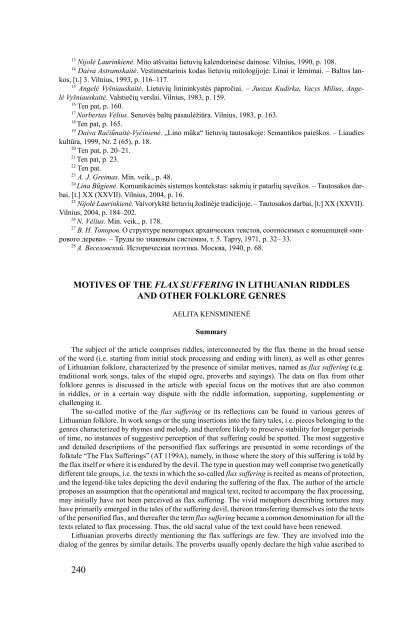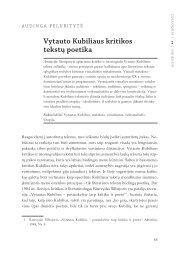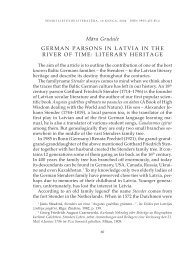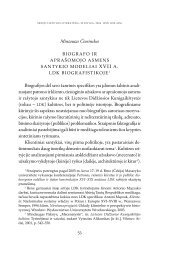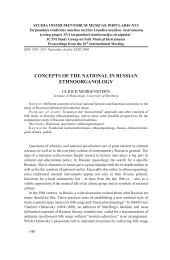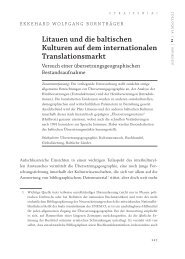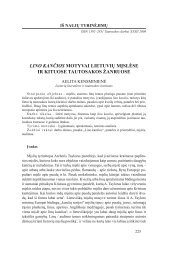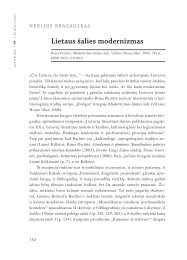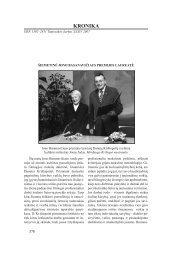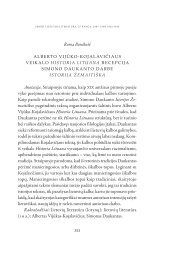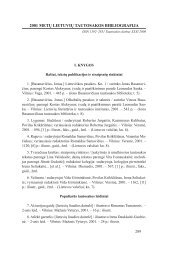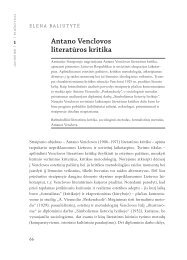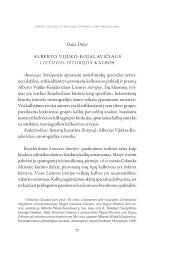tautosakos darbai xxxii - Lietuvių literatūros ir tautosakos institutas
tautosakos darbai xxxii - Lietuvių literatūros ir tautosakos institutas
tautosakos darbai xxxii - Lietuvių literatūros ir tautosakos institutas
Create successful ePaper yourself
Turn your PDF publications into a flip-book with our unique Google optimized e-Paper software.
13 Nijolė Laurinkienė. Mito atšvaitai lietuvių kalendorinėse dainose. vilnius, 1990, p. 108.<br />
14 Daiva Astramskaitė. vestimentarinis kodas lietuvių mitologijoje: Linai <strong>ir</strong> lėmimai. – Baltos lan-<br />
kos, [t.] 3. vilnius, 1993, p. 116–117.<br />
1 Angelė Vyšniauskaitė. <strong>Lietuvių</strong> linininkystės papročiai. – Juozas Kud<strong>ir</strong>ka, Vacys Milius, Angelė<br />
Vyšniauskaitė. valstiečių verslai. vilnius, 1983, p. 159.<br />
16 ten pat, p. 160.<br />
17 Norbertas Vėlius. senovės baltų pasaulėžiūra. vilnius, 1983, p. 163.<br />
18 ten pat, p. 165.<br />
19 Daiva Račiūnaitė-Vyčinienė. „Lino mūka“ lietuvių tautosakoje: semantikos paieškos. – Liaudies<br />
kultūra, 1999, nr. 2 (65), p. 18.<br />
20 ten pat, p. 20–21.<br />
21 ten pat, p. 23.<br />
22 ten pat.<br />
23 A. J. Greimas. Min. veik., p. 48.<br />
24 Lina Būgienė. komunikacinės sistemos kontekstas: sakmių <strong>ir</strong> patarlių sąveikos. – <strong>tautosakos</strong> dar-<br />
bai, [t.] XX (XXvii). vilnius, 2004, p. 16.<br />
2 Nijolė Laurinkienė. vaivorykštė lietuvių žodinėje tradicijoje. – <strong>tautosakos</strong> <strong>darbai</strong>, [t.] XX (XXvii).<br />
vilnius, 2004, p. 184–202.<br />
26 N. Vėlius. Min. veik., p. 178.<br />
27 В. Н. Топоров. О структуре некоторых архаических текстов, соотносимых с концепцией «мирового<br />
дерева». – Труды по знаковым системам, т. 5. Тарту, 1971, p. 32– 33.<br />
28 А. Веселовский. Историческая поэтика. Mосква, 1940, p. 68.<br />
MOTIVES OF THE FLAX SUFFERING IN LITHUANIAN RIDDLES<br />
AND OTHER FOLKLORE GENRES<br />
240<br />
aeLita kensMinienė<br />
Summary<br />
the subject of the article comprises riddles, interconnected by the flax theme in the broad sense<br />
of the word (i.e. starting from initial stock processing and ending with linen), as well as other genres<br />
of Lithuanian folklore, characterized by the presence of similar motives, named as flax suffering (e.g.<br />
traditional work songs, tales of the stupid ogre, proverbs and sayings). the data on flax from other<br />
folklore genres is discussed in the article with special focus on the motives that are also common<br />
in riddles, or in a certain way dispute with the riddle information, supporting, supplementing or<br />
challenging it.<br />
the so-called motive of the flax suffering or its reflections can be found in various genres of<br />
Lithuanian folklore. in work songs or the sung insertions into the fa<strong>ir</strong>y tales, i.e. pieces belonging to the<br />
genres characterized by rhymes and melody, and therefore likely to preserve stability for longer periods<br />
of time, no instances of suggestive perception of that suffering could be spotted. the most suggestive<br />
and detailed descriptions of the personified flax sufferings are presented in some recordings of the<br />
folktale “the Flax sufferings” (at 1199a), namely, in those where the story of this suffering is told by<br />
the flax itself or where it is endured by the devil. the type in question may well comprise two genetically<br />
different tale groups, i.e. the texts in which the so-called flax suffering is recited as means of protection,<br />
and the legend-like tales depicting the devil enduring the suffering of the flax. the author of the article<br />
proposes an assumption that the operational and magical text, recited to accompany the flax processing,<br />
may initially have not been perceived as flax suffering. the vivid metaphors describing tortures may<br />
have primarily emerged in the tales of the suffering devil, thereon transferring themselves into the texts<br />
of the personified flax, and thereafter the term flax suffering became a common denomination for all the<br />
texts related to flax processing. thus, the old sacral value of the text could have been renewed.<br />
Lithuanian proverbs d<strong>ir</strong>ectly mentioning the flax sufferings are few. they are involved into the<br />
dialog of the genres by similar details. the proverbs usually openly declare the high value ascribed to


